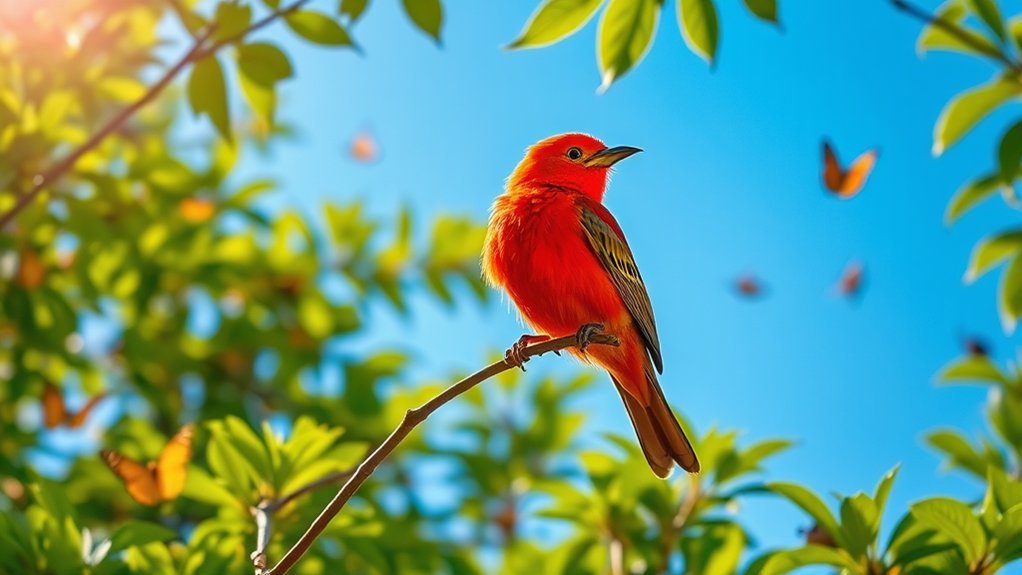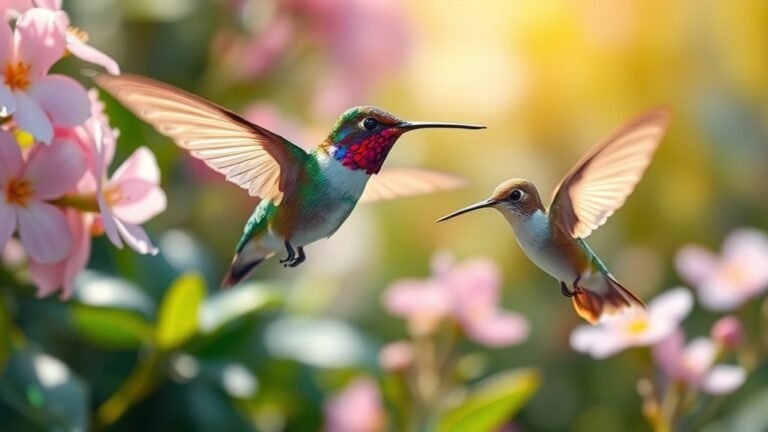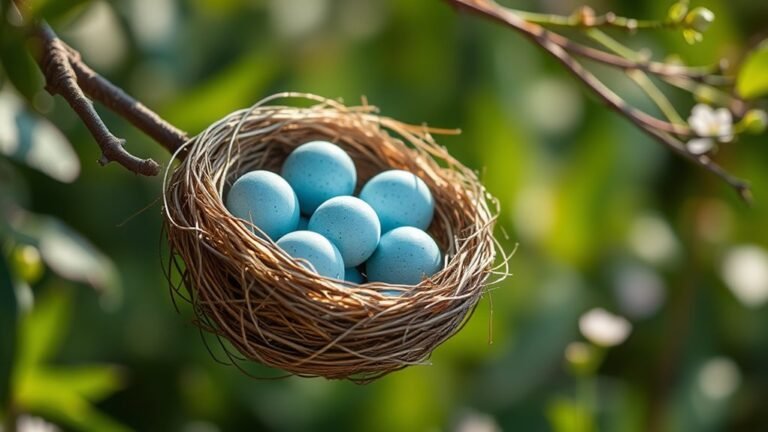Red Birds in Florida: A Complete Species Guide
In Florida, you can see various red birds, each suited to different habitats. The Northern Cardinal lives in wooded areas. The Scarlet Tanager prefers shrubby regions. Learning about their diets and breeding habits helps in birdwatching. These birds also play a vital role in their environment. Their presence contributes to maintaining ecological balance. Understanding this can raise awareness about their conservation needs.
Key Takeaways
Florida is home to several red birds, including the Northern Cardinal, Scarlet Tanager, and House Finch. Each bird occupies different habitats and environments across the state.
These birds eat a variety of foods. Their diets include seeds, fruits, and insects, showing how well they adapt to Florida's ecosystems.
Breeding habits differ among species. Most red birds build nests in trees or shrubs. This emphasizes the need for safe spaces where they can reproduce successfully.
Male red birds often use unique songs to communicate. These songs help them establish territory and attract mates.
Conservation efforts are vital for protecting these bird species. Raising awareness about their ecological roles encourages responsible birdwatching and fosters appreciation for Florida's wildlife.
Northern Cardinal

The Northern Cardinal, a striking avian symbol of the Southeastern United States, captivates birdwatchers and nature enthusiasts alike with its vibrant plumage and melodious songs.
You'll find cardinals thriving in diverse habitats, favoring shrubby areas, woodlands, and gardens. Their preference for dense foliage provides crucial cover and nesting sites, allowing them to assert their territory.
Observing cardinal behavior reveals their sociable yet protective nature; males often sing to assert dominance and attract mates, while females engage in nurturing roles.
You might notice their seed-eating habits, which are essential for maintaining energy levels, especially during colder months.
Understanding these aspects deepens your appreciation for cardinals, enhancing your connection with this iconic species and its role in the ecosystem.
Scarlet Tanager
Vibrant red and black plumage defines the Scarlet Tanager, an enchanting bird that punctuates the woodlands of Florida during its breeding season.
You'll find this species preferring mature deciduous forests, where rich canopies provide both shelter and a variety of food sources.
Importantly, their behavioral traits include:
- Vocalizations: Males produce a distinctive, throaty song to establish territory.
- Foraging habits: They actively hunt for insects, fruit, and berries within the dense foliage.
- Nesting: Females prefer to nest in isolated areas, showcasing a strong instinct for safety.
Understanding their habitat preferences and behaviors can enhance your appreciation of this stunning bird, making your birdwatching experiences in Florida even richer.
Summer Tanager

With its strikingly bright red body and contrasting darker wings, the Summer Tanager draws attention in Florida's open woodlands and along edges of suburban areas.
This species prefers habitats featuring spacious trees and shrubs, particularly those near water sources.
During summer breeding season, you'll notice males singing melodiously to establish territory and attract females, showcasing their vibrant plumage.
Nests are typically built in low tree branches or dense shrubs, offering protection from predators.
They primarily feed on insects and ripe fruits, adapting their diet to available resources.
House Finch
House Finches are a common sight in Florida, thriving in a variety of urban and suburban environments. Their adaptability to human landscapes marks them as remarkable birds.
To better understand House Finches, consider these key aspects:
- House Finch Behavior: They exhibit a social nature, often feeding and roosting in flocks.
- House Finch Habitat: You can spot them in parks, residential areas, and commercial zones, as they prefer regions with easy access to food and nesting sites.
- Diet Diversity: They enjoy seeds, fruits, and even scraps from your bird feeders.
American Robin

The American Robin, a familiar symbol of spring in Florida, is easily recognizable by its bright orange-red breast and cheerful song.
You'll often spot these birds in parks, gardens, and yards, where their versatile behavior shines. Robins typically forage on the ground for insects and berries, showcasing their adaptability to the American habitat.
Their melodious calls can indicate territory or attract mates, illustrating complex robin behavior.
During breeding season, they build their nests in shrubs or trees, often in close proximity to human dwellings, reinforcing their connection to our environments.
Understanding the habits and habitat preferences of American Robins allows you to appreciate their role in the ecosystem and fosters a deeper sense of belonging among birdwatchers and nature enthusiasts alike.
Red-shouldered Hawk
As you observe the vibrant landscape of Florida, keep an eye out for the Red-shouldered Hawk, a striking raptor that nests in wooded areas, often near wetlands.
Known for its adaptability, this bird showcases unique hunting behavior.
- Vocalizations: Its distinctive call resonates through the forest, marking its territory.
- Nesting Preferences: Typically, it chooses tall trees close to water sources, ensuring proximity to ample prey.
- Diet: This hawk primarily feasts on small mammals, amphibians, and reptiles, displaying keen hunting skills.
Red-bellied Woodpecker
Four primary features distinguish the Red-bellied Woodpecker in Florida's diverse ecosystems.
First, its striking red crown and nape contrast with its pale underbelly, making identification straightforward.
Second, you'll observe their characteristic foraging behavior; they cling to tree trunks while probing for insects. The red-bellied woodpecker's diet primarily consists of insects, especially beetles, along with a variety of fruits and nuts, providing crucial nutrition.
Third, their distinctive drumming sounds resonate through the forests, signaling territory presence.
Finally, this species displays strong social behavior, often found in pairs or small groups.
If you pay attention to these traits, you can appreciate the crucial role red-bellied woodpeckers play in maintaining Florida's ecosystems. Their unique characteristics foster deeper connections within this avian community.
Painted Bunting
While exploring the vibrant landscapes of Florida, you'll likely catch a glimpse of the Painted Bunting, a bird celebrated for its stunning plumage. This avian gem showcases a spectacular array of colors, making it a favorite among birdwatchers and nature enthusiasts alike.
Understanding its migratory patterns can deepen your appreciation for the Painted Bunting.
Here are three fascinating aspects to note:
- Colorful Plumage: Males exhibit a brilliant mix of blue, green, and red, while females lean towards subtle brown tones.
- Breeding Habitats: They prefer shrubby areas, often found near water sources.
- Migration Journey: Painted Buntings migrate from the southeastern U.S. to Central America, showcasing remarkable navigation skills.
Embracing the beauty of this species can foster a stronger connection to Florida's rich biodiversity.
Vermilion Flycatcher
The Vermilion Flycatcher stands out as one of Florida's most striking birds, enchanting observers with its vivid red plumage and charismatic presence.
You'll notice its preference for open habitats, often found in parks, fields, and the edges of wetlands. This bird displays interesting behavioral traits; it actively perches in visible spots, patiently waiting to catch insects mid-air, showcasing its impressive agility.
During breeding season, males perform aerial displays to attract females, exemplifying their vibrant nature. They tend to favor nesting near water sources, which provide abundant food resources while ensuring safety from ground predators.
Engaging with the Vermilion Flycatcher deepens your connection to Florida's avian diversity, enriching your understanding of the region's ecosystem.
Red-winged Blackbird
One of Florida's most recognizable birds, the Red-winged Blackbird, captivates birdwatchers with its striking black plumage and vibrant red shoulder patches.
You'll often find these birds in wetlands, marshes, and grasslands, showcasing their preference for open habitats near water.
Here are three fascinating aspects of their behavior:
- Territorial displays: Males use bold vocalizations and impressive flights to defend their territories.
- Feeding habits: They primarily eat seeds and insects, foraging in grasses and reeds, which showcases their adaptability.
- Nesting: They create nests in dense vegetation, ensuring protection for their young from predators.
Understanding their habitat preferences and feeding habits reinforces your appreciation for the ecological role Red-winged Blackbirds play in Florida's diverse environments.
Rose-breasted Grosbeak
Shifting your focus from the striking Red-winged Blackbird, the Rose-breasted Grosbeak offers another eye-catching presence in Florida's avian landscape.
Known for its bold, contrasting plumage, this bird exhibits fascinating breeding habits, often nesting in deciduous forests. During the spring, you'll witness males singing to establish territory and attract mates, showcasing their vibrant pink chest.
As a migratory species, the Rose-breasted Grosbeak travels extensively, arriving in Florida primarily during the warmer months. Their migratory patterns are influenced by food availability, particularly insects and berries.
Understanding these behaviors enhances your appreciation for the interconnectedness of avian life, reinforcing your sense of belonging within Florida's diverse ecosystem. Spotting this colorful bird can be a rewarding experience, enriching your birdwatching pursuits.
Common Redpoll
Among the smaller avian visitors to Florida, the Common Redpoll captivates with its lively behavior and social feeding habits.
These energetic birds often flock together, adding a joyful ambiance to any landscape.
Here are three significant aspects of the Common Redpoll:
- Common Redpoll Habitat: You'll typically find them in open woodlands and shrubby areas, especially during the winter months.
- Common Redpoll Behavior: Their penchant for feeding in tight-knit groups allows them to exploit food sources effectively, often seen foraging on seeds from grasses and birch trees.
- Migration Patterns: While primarily a northern species, they occasionally venture south, offering you a delightful spectacle.
Understanding these traits can enhance your appreciation of their presence in Florida's rich ecosystem.
Crimson-collared Grosbeak
The Crimson-collared Grosbeak stands out with its striking plumage and enchanting behavior, making it a remarkable addition to Florida's avian landscape.
You'll notice its bright red and black feathers, which serve as a beacon, attracting both birdwatchers and enthusiasts.
This species exhibits fascinating behavioral characteristics, including a melodious song and social feeding habits, often foraging in small flocks.
You'll appreciate how they adapt to both rural and suburban environments, showing a unique resilience.
However, it's crucial to be aware of their conservation status, as habitat loss poses a significant threat.
Engaging in local conservation efforts can help maintain their presence in Florida, ensuring that these beautiful grosbeaks continue to enrich your birdwatching experiences.
Frequently Asked Questions
What Are the Best Spots to See Red Birds in Florida?
To see red birds in Florida, visit wetlands and parks. Good locations for bird watching are the Everglades and local nature reserves. These areas host many bird species that enjoy their natural habitats. Take time to quietly observe the birds for the best experience.
When Is the Peak Migration Season for Red Birds in Florida?
The peak migration season for red birds in Florida happens during spring and fall. These seasons are important for their migration and breeding. If you want to see red birds, observing them during these times is best. This increases your chances of spotting them easily.
How Can I Attract Red Birds to My Backyard?
To attract red birds, place birdbaths near plants that have seeds or berries. Use native plants to provide food for the birds. Keep the water sources clean. This will help create a friendly space for your visiting birds. Enjoy watching them!
Are There Any Conservation Efforts for Red Bird Populations?
Yes, there are conservation efforts for red bird populations. These efforts focus on habitat preservation. You can help by supporting local conservation groups, which work to protect these birds. Raising community awareness also plays a key role in ensuring the survival of red bird species. Your involvement can make a difference in their future.
What Bird Feeders Are Best for Attracting Red Birds?
To attract red birds, use these types of feeders:
- Tube Feeders: Fill them with sunflower seeds. Red birds enjoy these seeds and will visit often.
- Platform Feeders: Offer mixed seeds in these feeders. They are open and easy for birds to access.
- Suet Feeders: Provide protein-rich suet. This attracts red birds and supports their energy needs.

Kashvi is a passionate bird enthusiast and nature lover who has been fascinated by the world of birds for years. With a keen eye for detail and a love for learning, Kashvi is dedicated to sharing her knowledge and insights with fellow bird enthusiasts on Avian Enthusiasts. Through her engaging and informative articles, Kashvi aims to inspire others to join her in exploring the fascinating world of birds and to promote a deeper appreciation for these incredible creatures.







